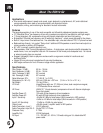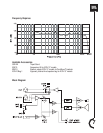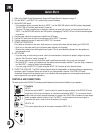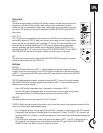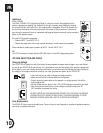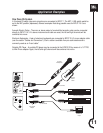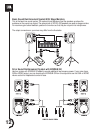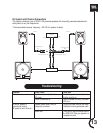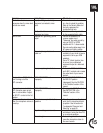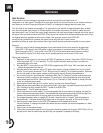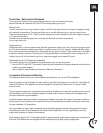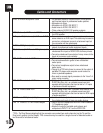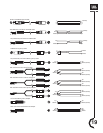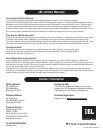
Connections - Balanced and Unbalanced
There are two basic types of audio system interconnections for very low to medium level audio
signals: Balanced and unbalanced.Your EON10 G2 can accept either type of input.
Balanced Lines
In audio, a balanced line is a three-conductor system in which the two signal wires carry an equal, but opposite voltage
with respect to the ground wire. The ground wire acts only as a shield and does not carry any audio signal current.
Outside interference (such as RFI
_
Radio Frequency Interference) is either shielded from the internal signal conductor,
or if it gets into the cable, is
cancelled out by the opposite signals at the receiving end. Balanced connections are preferred
for any longer cable runs.
Unbalanced Lines
Unbalanced cable is a two-wire system where the shield (ground wire) acts as one of the current carrying signal conduc-
tors.The center conductor enclosed by the shield is commonly known as the “hot” conductor. Unbalanced audio cables
do not reject noise as well as balanced lines. Unbalanced lines are typical in home hi-fi type systems and on the outputs
of electronic musical instruments.These work well if the distance between the components is short, the signal level is
relatively high and all of the electronics used in the system are plugged into the same AC service.
Unbalanced Sources to EON Powered Loudspeakers
If you need to connect your EON speakers to an unbalanced source you have two options:
• Use the INPUT 2 and INPUT 3 connectors.These inputs are balanced but will accept unbalanced inputs without the
need for any special adapters.
• Use an adapter or special cable (see the section “Cables and Connectors”).
Loudspeaker Placement and Mounting
The following guidelines will help you achieve optimum sound wherever you use your EON loudspeakers:
Raise the speakers as high as possible. For best results try to get the high frequency horn at least 2 to 4 feet above the
heads of the audience. If the speakers are too low, the people in the back of the audience will not receive the best
quality of sound.
Place the speakers between the microphones and the audience. Feedback occurs when the microphones pick up sound
from the speakers and “feed” the sound back through the sound system. If space is limited, point the speakers away
from the microphones to reduce feedback.
Locate the speakers away from turntables. Low-frequency feedback occurs when the output of the speaker is picked up
by the tone arm of the turntable and is re-amplified. A heavy, solid turntable base and shock mounting can also reduce
this type of feedback in DJ applications.
Use more speakers in large or highly reverberant spaces. Spreading speakers throughout these spaces will produce
much better sound than trying to compensate with loudness level or equalization. For very long distances, the use of
another set of speakers on a delay is recommended.
Stand speakers upright for PA - Tilt the speakers back for stage monitoring. Upright stance provides even coverage over a
wide area. EON speakers are also designed with two slanted positions for stage monitoring applications.
17



